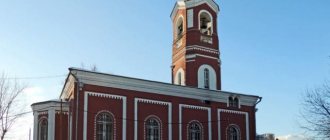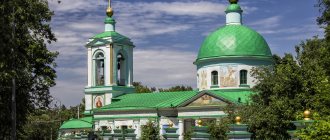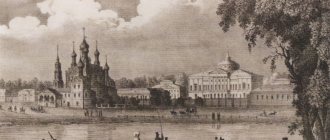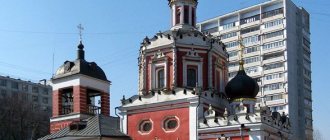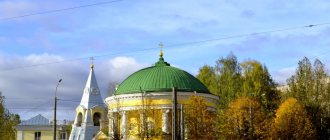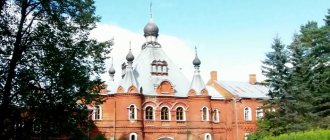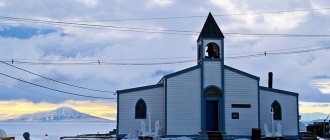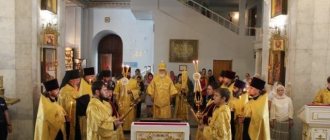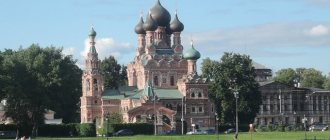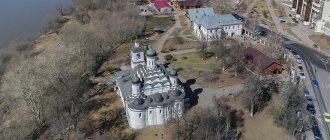Address: Troitskaya street, 38, Tver, Russia. Telephone. Opening hours: from 8:00 to 19:00. How to get there: from the bus station by buses No. 7 and No. 2, get off at the stop “pr. Kalinina". Religion occupies a significant place in human life, therefore, most people treat buildings such as temples and churches with honor. In every city it is easy to visit such an establishment to pray and turn to God for help. And if the cathedral is very ancient, then it also becomes a real attraction not only for local residents, but also for tourists. In Tver, the oldest church is the White Trinity. Why is it so attractive to tourists?
Church history
Russian historian, researcher of Russian architectural antiquity Yuri Ivanovich Shamurin in his book “Cultural Treasures of Russia.
Tver. Tula. Torzhok,” published in 1913, wrote: “... when studying Tver antiquity, one cannot ignore the White Trinity. It belongs to the most interesting era of Russian architecture, according to many - the golden age of Russian creativity in the mid-16th century. Stone monuments of this time were relatively few in number, and very few have reached us in good preservation. Much has been added to the White Trinity, but little has been disrupted; this makes it a particularly valuable monument.” The author further notes that the church has preserved many everyday features of the 16th century. There is an opinion that the temple originally had three domes, but was rebuilt in the 17th century and became seven-domed. The central chapter is adjoined from the north and south by smaller domes, two more are placed on the western corners, and on the eastern corners there are the smallest domes, which, breaking the symmetry, give an original rhythm to the entire building. The main part of the building is close to the circle of Moscow monuments of the 16th century, with elements of the local artistic tradition.
8 years after the construction of the temple G.A. Tushinsky bequeathed it and his courtyard to the Trinity-Sergius Monastery.
In 1787, the Ephraim limit was added to the main cubic volume of the church, in 1812 - a two-tier bell tower, which was later built on, and in 1864-1867 the chapel of St. Arseny, Bishop of Tver and Martyr Tatiana was added.
Church architecture
The church was an extremely majestic building, which had an unconventional completion for those times. Instead of the usual five-domed structure, one large chapter was first erected, and over time six more small ones were added - in two rows. Other structures were also added - a refectory and a bell tower. Everything in the complex created a very cozy and attractive church. At first, the roof was sloping, and from 1787 it was hipped with planks. After another 6 years, the narrow windows were cleared to allow more sunlight to penetrate inside, the northern entrance was moved, and new paintings were made on the walls. The iconostasis did not remain unchanged. At the beginning of the 19th century, the white tiles on the domes were replaced with tinned iron, and the new bell tower building had only two tiers. By the end of the century, the third tier and the tent top were completed.
History of the temple
In the pre-revolutionary period, the Trinity Church sometimes played the role of the city cathedral. This happened at a time when the Spaso-Preobrazhensky Cathedral was being repaired. Considering that during the period of the Soviet Union, services were prohibited, they were not stopped at the White Trinity. There is evidence that this was influenced by its remoteness from the city's busy center. During World War II, the temple was temporarily closed, but the Nazis were able to open it and desecrate it. Only after the end of hostilities did services resume here and have not stopped to this day. It’s a pity, but modern Orthodox believers cannot observe an absolutely white church, since two decades ago the domes became helmet-shaped, and their color was changed to black.
Legend associated with the White Trinity
There are many stories about the temple, but one of them tells that under it there is an underground passage 250 m long, which once led all the way to the Tver Kremlin. It was thanks to him that local residents escaped from enemy attacks. But modern archaeologists refute this story - they could not find it during excavations.
Shrines of Tver Church
Until 2012, the main shrine of the temple was considered to be a shrine with the relics of Macarius of Kalyazinsky. When a religious procession was held, the reliquary with them was carried around the cathedral building. During the Volga religious procession, the relics were transferred to another shrine, which was placed in the saint’s homeland - in Kalyazin, namely in the Church of the Ascension of the Lord. Part of the relics and the old shrine remained in the White Trinity Church in Tver. The painting on the walls here dates back to a long period of time - from the 17th to the 19th centuries. Separately, it is worth mentioning the fresco “Royal Doors”, painted in the 18th century in the famous Rococo style. The main iconostasis also contains many ancient icons. Many tourists recommend visiting this church in Tver, because this way you can “touch” the ancient things and feel the peaceful atmosphere of the holy place. In addition, it has an excellent location - surrounded by a spacious area and green spaces. The White Trinity is distinguished by its ancient history and the attractive tranquility felt in the majestic religious building!
Temple today
In the 90s of the 20th century, a large-scale reconstruction of the cathedral began, in which divine services did not stop even in Soviet times.
In 2014, on the eve of the 450th anniversary, all restoration and repair work was completed. On October 12, Metropolitan Victor of Tver and Kashin consecrated the main altar of the Trinity Cathedral. And on December 14, the thrones in the chapels of the holy martyr Tatiana and the Monks Ephraim and Arkady of Novotorzh were consecrated.
Today, in the White Trinity Church one of the shrines of the Tver land is kept - a shrine with the relics of St. Macarius of Kalyazin, moved here in the 30s of the twentieth century, after the destruction of the Trinity Monastery in Kalyazin.
White Trinity Church
Basic moments
There are several urban legends about the ancient temple.
According to one legend, there was an underground passage 250 fathoms long near the White Trinity Church. Valuable church property was kept here, and in the event of an enemy raid, local residents could hide. They tried to discover the mysterious dungeon many times, but no one has managed to find it yet. The cathedral contains four altars and contains valuable icons from the 16th century, as well as ancient liturgical utensils. Here you can see a carved iconostasis of the 18th century, paintings on the walls made at the turn of the 18th-19th centuries, and a shrine with the relics of the revered Tver wonderworker Macarius of Kalyazinsky (1402-1483).
More recently, the White Trinity Church was restored. Nowadays, it has the status of a cathedral of the Tver Metropolitanate and is governed by the ruling bishop. The doors of the temple are open to pilgrims and tourists every day from 8.00 to 20.00, and services are held there as scheduled.
History of the White Trinity Church
The first settlements in Zatmachye arose in the 14th-15th centuries. The territory of the wooden settlement, which grew up away from the ancient Tver Kremlin, was limited by the right bank of the Volga and the left bank of the Tmaka River. The chronicles contain records of a big fire in 1483, from which more than 40 households burned out in the settlement.
The White Trinity Church appeared in the city in 1564. Money for its construction was allocated by a merchant from Moscow Gavrila Andreevich Tushinsky, whom Ivan the Terrible sent to the Tver lands to collect trade duties. At the very beginning, this church was three-domed and had a figured roof covering. Each of the three apses was also covered by a separate hemisphere. In the 17th century, the temple was rebuilt and two more domes were added.
At the end of the 18th century, the Ephraim chapel appeared at the White Trinity Church, and the slit-like window openings were cleared out so that there was more light inside. In 1812, a slender bell tower with two tiers was built near the temple, and by the end of the 19th century a third tier and a high tent were added to it.
In 1777, Zatmatsky Posad was redeveloped, as a result of which the White Trinity Church was located on the outskirts of Tver, near the Staritskaya outpost. It served as the “front gate” of the city for everyone who approached Tver from the direction of Staritsa. Then a whole block of residential buildings grew up next to the temple, and it began to occupy a central place in Zamachye. At the intersection of two streets running side by side, Trinity Square was built, and the street leading towards the Tver Kremlin was called Trinity after the name of the temple.
During the years of Soviet power, many churches in Kalinin, as Tver was then called, were closed or destroyed, so since 1962, the church in Zamachye remained the only one in the city for a quarter of a century.
Architecture Features
The White Trinity Church was built of white stone and brick, plastered and whitewashed. Together with the dome and cross, it rises to 27.7 meters. Among the surrounding one-story buildings, the tall temple looks very majestic.
The harmonious church complex consists of a cubic two-height church, a one-story refectory and a three-tier hipped bell tower. The temple itself is covered with a hipped roof, above which rise seven expressive helmet-shaped domes - one large in the center and six small ones around it.
The architecture of the White Trinity Church is distinguished by clarity and simplicity of forms, as well as restrained decor. The walls of the temple are divided by strict blades, and the upper part of the building is decorated with a three-part cornice.
How to get there
The White Trinity Church stands in the center of Tver, on Troitskaya Street, 38. You can get to the temple by trolleybuses No. 2 and 4, bus No. 20 or minibuses No. 6, 7, 9 and 52. You need to get off at the “First City Hospital” stop.
Construction of the main temple of Tver
Temples, first of all, were built in the Kremlin. The streets diverging in all directions from the Kremlin formed a posad, a place where the townspeople lived. The domes of churches could be seen everywhere between the roofs of the townsmen's huts. In ancient times, almost all townspeople's churches were wooden, but one ancient stone church has survived in Tver.
The construction of a stone church in those days was an expensive and troublesome task, therefore princes, boyars or rich merchants could build a stone church. In 1575, the Moscow merchant Gavril Andreevich Tushinsky began to build the White Trinity in Tver, but he did not have enough money, and therefore another merchant, Peter Lamin, gave the missing part of the funds. The walls of the temple were made of red brick, but people still called the church, red as an Easter egg, the White Trinity.
Why white?
Trinity-Sergius Lavra is the heart of Russian Orthodoxy. Gavril Andreevich Tushinsky came here to present the Lavra of St. Sergius with the newly built White Trinity Church in Tver.
In Rus' at that time there were 2 concepts: black and white lands. The sovereign exempted the owners of white lands from part of taxes for special merits. The Trinity-Sergius Lavra and everything that belonged to this monastery were precisely exempted from part of the taxes by state decree. Now the former tax benefit lives on in the historical name - White Trinity in Tver, and later the church walls themselves were plastered and whitewashed.
The White Trinity Church is the oldest existing temple in Tver. It is already more than 450 years old. It was built in 1564 at the expense of the Moscow merchant Gavrila Andreevich Tushinsky and played an important role in the life of the city. In Soviet times, after the closure and demolition of the main church of the city, the White Trinity became the cathedral church of the diocese. There are many legends associated with Trinity Church. For example, they said that a 250-meter underground passage led from the church, which saved local residents during enemy attacks. However, during excavations in 1873, nothing of the kind was found.
Church history
Russian historian, researcher of Russian architectural antiquity Yuri Ivanovich Shamurin in his book “Cultural Treasures of Russia. Tver. Tula. Torzhok,” published in 1913, wrote: “... when studying Tver antiquity, one cannot ignore the White Trinity. It belongs to the most interesting era of Russian architecture, according to many - the golden age of Russian creativity in the mid-16th century. Stone monuments of this time were relatively few in number, and very few have reached us in good preservation. Much has been added to the White Trinity, but little has been disrupted; this makes it a particularly valuable monument.” The author further notes that the church has preserved many everyday features of the 16th century.
There is an opinion that the temple originally had three domes, but was rebuilt in the 17th century and became seven-domed. The central chapter is adjoined from the north and south by smaller domes, two more are placed on the western corners, and on the eastern corners there are the smallest domes, which, breaking the symmetry, give an original rhythm to the entire building. The main part of the building is close to the circle of Moscow monuments of the 16th century, with elements of the local artistic tradition.
8 years after the construction of the temple G.A. Tushinsky bequeathed it and his courtyard to the Trinity-Sergius Monastery.
In 1787, the Ephraim limit was added to the main cubic volume of the church, in 1812 - a two-tier bell tower, which was later built on, and in 1864-1867 the chapel of St. Arseny, Bishop of Tver and Martyr Tatiana was added.
Interior of the cathedral
The iconostasis of the temple was created at the end of the 17th century; before the revolution, it was decorated with icons from an earlier period. Researchers date the wall paintings to the period of the late 18th - mid-19th centuries.
A hiding place was placed between the domes and vaults of the temple, which could only be accessed through a hole in the roof. The cache was intended to preserve church valuables in the event of an enemy attack.
Temple today
In the 90s of the 20th century, a large-scale reconstruction of the cathedral began, in which divine services did not stop even in Soviet times.
In 2014, on the eve of the 450th anniversary, all restoration and repair work was completed. On October 12, Metropolitan Victor of Tver and Kashin consecrated the main altar of the Trinity Cathedral. And on December 14, the thrones in the chapels of the holy martyr Tatiana and the Monks Ephraim and Arkady of Novotorzh were consecrated.
Today, in the White Trinity Church one of the shrines of the Tver land is kept - a shrine with the relics of St. Macarius of Kalyazin, moved here in the 30s of the twentieth century, after the destruction of the Trinity Monastery in Kalyazin.
"Ancient Tver." How we built a stone church in honor of the Holy Life-Giving Trinity beyond the Volga
The Tverigrad.ru portal and the famous Tver blogger and local historian Igor Marchenkoff present the eighty-fourth issue of the “Ancient Tver” project, in which photographs, images, facts, stories and legends show what the city was like yesterday and what it has become today.
The stone Trinity Church beyond the Volga was built in 1734 - 1737. One of the architectural monuments of Tver - the Trinity Church beyond the Volga - has regained its historical appearance. Tver Church in honor of the Life-Giving Trinity, which is beyond the Volga, is located next to the River Station, not far from the Assumption Cathedral of the Otroch Monastery, next to the bridge over the Tvertsa.
It was erected during dramatic events. At the beginning of the 18th century, wealthy people for their time, the richest Tver merchants Matvey and Alexey Arefiev, decided to build their family church, which was customary at that time. The construction of a stone church in honor of the Life-Giving Trinity (on the site of a former dilapidated wooden church) began in the lean year of 1734 at the expense of merchants who, in order to support the starving, gave them work (by the way, in the house of the Arefiev merchants, also nearby, there is a Museum of Tver Life). The wooden Trinity Church that stood on this site was dismantled and taken to the village of Bor, Tver district.
The new Trinity Church with plastered brick walls and white stone facade decoration was consecrated in 1737. In 1847 - 1848, according to the project of I.F. In Lvov, the southern aisle of the temple was built. Later the refectory was expanded, its porch and vaults were redone and they were painted again. The photo in front of the church shows Trinity Square, which disappeared during the construction of the dam to the Zatveretsky Bridge.
The architecture of the temple is traditional for the beginning of the 18th century, but there are also unique distinctive features - a hipped bell tower, which was destroyed after the revolution and restored in the 80s of the last century. The white stone carved window casings, entwined with vines, with a magnificent, very luscious baroque ornament, have been preserved in good condition. In the upper part above the pediment there are three images of flaming candles - this is an image of the tree of life, three fragments symbolize the Life-Giving Trinity, to which this temple is dedicated. Inside the temple you can clearly see where the iconostasis was located; its dimensions were considerable. The real pearl of the church is the wall paintings, which were allegedly created in 1817. The uniqueness of the monumental painting of the Life-Giving Trinity Church lies in the fact that a whole complex of frescoes has been preserved here to this day. Such large-scale and original paintings are especially rare for our city. The subjects of the painting tell about the coronation of the Mother of God, this can be seen in the dome of the temple. Also among the subjects of the compositions are the Mystery of Jesus Christ, the twelve Apostles, and the ten beatitudes of the Gospel. The frescoes are distinguished by the grisaille technique, which creates the effect of volume and carving. Now this monumental painting is temporarily unavailable to parishioners.
After the revolution, in the 1930s of the 20th century, the temple was closed and destroyed - the bell tower was destroyed (restored in the 80s), the internal space was divided into three floors and partitioned with concrete walls, the domes above the temple and altars were dismantled, as well as tier of ringing bell tower with tent. During the Great Patriotic War and after, the temple building housed a dairy factory, the wall paintings were mercilessly painted over with oil paint, and the altars were desecrated.
The photo shows house No. 28, which was demolished due to the construction of the Trans-Volga continuation of Cooperative Lane, which in 1971 received the name Komsomolsky Prospekt, and the transfer of the beginning of the western embankment of the Old Tveretsky Bridge to the intersection of this continuation and Verkhovskaya Street (since 1953 - Gorky Street ). Previously, the embankment began to the east, at the intersection with Shevchenko Lane; it was moved in 1949, and it passed through the courtyard of house 28. Soon the wooden extension was demolished; the photograph shows traces of it on the left wall. It can be seen that the house in the picture has already been occupied and will soon be demolished. In the background you can see the former Trinity Church beyond the Volga, which at that time housed a dairy factory.
In 1986 - 1991, during restoration work, the bell tower tent was restored, and the newly installed dome was gilded. The domes of this particular Tver temple were gilded for the first time during the years of Soviet power - money for this was given by a descendant of the priest who served in this temple, who then lived in the USA.
They say that some of the offices of this office were also located in the altars of the temple, and the employees of this organization, forced to constantly be where they should not be during working hours, told us with sorrow and bewilderment how their colleagues were dying from cancer one after another.
On September 27, 2005, the cross on the dome was restored. The consecration of the cross on the dome was performed by the rector of the Znamenskaya Church in the village of Savvatyevo, priest (at that time) Andrei Egorov. Before the transfer of the church to the Russian Orthodox Church in 2010 and the start of restoration, the Tver regional film distribution center, as well as its parking lots and repair shops, were located on the territory of the temple.
Based on materials from the websites of the Tver diocese and hram-tver.ru.
Photos are also used from the collections of TGOM, GATO, TOKG, the archives of the GET museum and the newspaper “Kalininskaya Pravda”, the State Central Museum of Contemporary History of Russia, the album “Kalinin”, “Streets of the City of Kalinin. Directory" ed. Moscow worker 1978 and author
If you find an error, please select a piece of text and press Ctrl+Enter.
18
0
